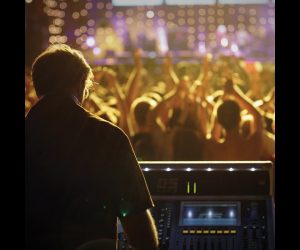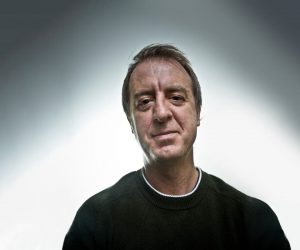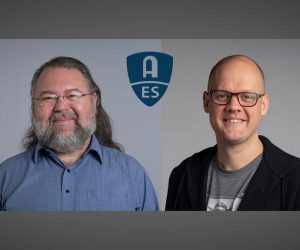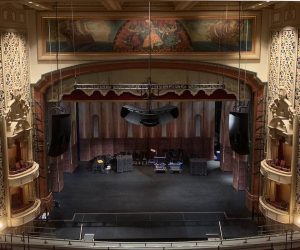
Bruce Jackson: Life on the Cutting Edge
Bruce Jackson is arguably the most versatile, most influential, most innovative man in audio. We track Bruce down to his Santa Monica hangar for a natter.
This was classic Bruce Jackson: I was on one end of the phone from my home on the outskirts of Melbourne, Bruce was on the other from his private aeroplane hangar at Santa Monica Airport. This is where Bruce’s plane has been located for many years and apparently it’s all getting a bit messy in the hangar…
“Anything in Los Angeles that sits in storage for a while gets this layer of black soot all over it,” Bruce starts up. “It’s all over the floor, all over the boxes… so I’m currently in the process of clearing the decks in here. There’s stuff everywhere from floor to ceiling: tools, microphones, EQs, an old Clair folding console… it’s a real mess. I’ve had this space for I don’t know how long – decades I guess – so stuff has piled up.”
While Bruce is saying all this quite matter-of-factly, I’m on the other end of the blower thinking to myself: ‘Who on earth has their own private plane and hangar, besides maybe André Agassi and U2?’ No matter how normal or nonchalant Bruce Jackson tries to be, every time I talk to him he’s doing something outside the square, and the more he tries to play it down the weirder it seems to get.
Whether he’s supervising the sound for an Olympic Games, testing a new top-secret Dolby surround format – “unfortunately I can’t speak about that just yet” – or clearing the crap out of his hangar under the shadows of the airport control tower, Bruce is always up to something.
And so it has always been. In his teenage years Bruce did what all Sydney boys do (not): he built PAs, TV sets out of radar tubes, guitar amps and speaker columns. He even built a makeshift radio station with his school buddies from where they used to broadcast illegally on the AM band via, as Bruce puts it, “a highly efficient antenna” that spanned the length of the school and was too efficient as it turned out: “We thought we were broadcasting across the neighbourhood when, in fact, we were actually transmitting right across Sydney. Eventually the PMG van triangulated in on us, busted us and shut us down. But it was fun while it lasted.”
In his twenties Bruce’s career took off, quite literally. By the time he was 21 he’d secured his pilot’s licence, established, developed and already sold the successful manufacturing, PA and lighting company, Jands, and moved to the United States. (Jands, by the way, is an abbreviation of Jackson and> Storey – Storey being Phil Storey, his partner in crime and the ‘S’ in Jands). Over in the US Bruce worked for the regional PA hire company, Clair Brothers, where he designed (along with Ron Borthwick) the foldout console, which Bruce subsequently used regularly on tour as FOH mix engineer for Bruce Springsteen during the 1980s.
In the early ’70s, this mix of electronics tinkering and touring led to an event that defined Bruce’s career:
“It was during my tenure at Clair Brothers that Elvis Presley started touring again. Initially many different sound companies did Elvis’s sound on a regional basis. Fortunately (for me, as it turned out) most had problems with the logistics of hanging the PA – and they didn’t notice the troubles we were also having – so before I knew it I’d become Elvis’s touring engineer. It was an exciting time and a period of great innovation. It was the first time a live show had hung the sound system from the now ubiquitous CM chain hoists (although the Ice Show had previously hung a very basic rig) – not for sound quality reasons mind you, which is why they do it now, but so the Colonel could sell every seat in the house. We had to turn them upside down to enable them to pull themselves up the chain; a standard practice nowadays. The PAs were much smaller then of course, but I still don’t know how we ever got away with it. It was all evolving and real seat-of-the-pants stuff.”
CUTTING EDGE
Bruce Jackson has often been described in this magazine as ‘audio royalty’, and not only because of his association with The King. Way back in Issue 40 when Bruce appeared in our ‘Name Behind the Name’ series, I described him in these terms:
Bruce Jackson has always worked at the cutting edge of technological advancement, but unlike many others in the audio industry, his youthful perspective has never waned. As most people gain experience and become established in a field of expertise a strange and ironic process begins to engulf them. Their knowledge and skill – the very thing that defines them as experts – tends to date them, and the learning of new ‘tricks’ becomes harder and harder until eventually they’re outmoded. Not so with Bruce. He’s as cutting edge now as he has ever been. Ideas are in plentiful supply and there is always a new and innovative audio solution just around the corner.
This statement still rings true today…
DOLBY LABS
Apart from his recent involvement in the sound production of two of the biggest gigs of recent times – the Winter Olympics in Vancouver and the World Expo in Shanghai – Bruce is currently involved on a full-time basis with Dolby Laboratories, where he’s working on a small team that goes by the name of: “Platforms and Products”.
“We fit between the research side of things and the product side,” Bruce explains, “developing and promoting new technologies. It’s a bit of a departure from my live sound world – I’ve never worked for a large company before. Mind you, with under 1000 employees, Dolby is not a large company, but it still feels that way to me. I’m really enjoying the exposure to all the cool technology of the non-hardware world. And Dolby really looks after its people.”
His relationship with Dolby probably needs some explanation at this point, as his association with the company is no accident. Clair Technologies LLC was the company that Bruce, his partner David McGrath and Clair Bros Audio forged in the late ’90s and early noughties, where cutting-edge speaker management systems like the Contour and Lake Processor were built. This company eventually evolved into Lake Technology in 2001 and was acquired by Dolby in 2003. I remember quizzing Bruce about this soon after the deal went down and getting a cagey and somewhat mixed response that involved a lot of gazing into the distance, long pauses in the conversation and internal musing. This had been his baby after all, and now it was out of his hands. In the half a dozen or so years since the takeover I was curious to know if this caginess remained:
“I’m really enjoying it actually, although David McGrath and I were really disappointed that Dolby chose to not continue making our live sound products any more – they couldn’t have been more successful after all. Most big sound companies loved the technology, but from a Dolby perspective it was a very small business.”
But how was this possible? Seemingly every large event involving a PA, whether it was a rock concert, Commonwealth Games or Football Grand Final used a Dolby Lake Processor – several in most cases – and in each case they seemed to be linchpins of the system. How could Dolby have put the kibosh on such a successful processor, and more significantly, how did Dolby not know that the live sound industry was, as Bruce put it: “a very small business?”
“I think the feeling was that it would grow, but then they looked at my engineering team and said: ‘If we put your guys onto mobile phones and online gaming development we could grow much, much bigger, much, much faster…’ and that’s basically what happened. So essentially my live sound team suddenly found themselves developing apps for mobile phones and that’s proved to be very successful.”





CINEMA ADVANCES
Dolby is of course synonymous with the cinema, noise reduction technology and various other hi-tech developments at both the professional and consumer level. Bruce is no slouch with a digital algorithm himself so the inevitable question of what’s currently under development at Dolby was eventually raised. This was the response from the hangar:
“We’ve been developing some cool stuff relating to the cinema space, and experimenting with different multi-speaker surround sound formats that we’ve been testing at Skywalker Sound using Avatar as the guinea pig. We’ve mixed it in a variety of formats through new speaker configurations, so all in all it’s pretty interesting.
“The important thing is that we’re conscious of the fact that you constantly need to raise the bar, so we’ve been working on potential new formats and that’s why we’re showing, for example 11.1 at the cinema trade shows.
It’s pretty effective, but the trick with it is to be able to take that format and down-mix it. With some of these new experimental formats there’s now a vertical component. So, for instance, in the case of Avatar, we were able to make the helicopters feel like they were flying over you, which sounded pretty amazing. You’d be surprised how enveloping it is when you add these extra channels. With this format a mix engineer is able to pan a sound up into the ‘left-height’, ‘right-height’ screen channels, and from there into the left and right ‘voice of god’ speakers and all the way though to the back left and right rears on the back wall. That’s really, really effective.
“There are scenes in Avatar where the main characters are in the forest and the canopy is alive with the sound of all these weird creatures… using this format it sounds pretty amazing. Combined with the Dolby 3D image rendering dichroic glasses, as opposed to the polarised 3D, which has a certain degree of cross-talk – there’s full-immersion. The philosophy behind it is that if you’re going to go to the cinema you want to have an experience you can’t have at home.”
GAINING SOME PERSPECTIVE
When you can rattle of acts like Elvis Presley, Johnny Cash, Barbara Streisand, Bruce Springsteen, Dianna Ross, Fleetwood Mac, Stevie Wonder, Rod Stewart and the Faces, Barry White, Jefferson Airplane and Ozzy Ozbourne as but a small fraction of the names you’ve worked with in your career, you’re in an extreme elite. In fact, in some respects Bruce is without peer. From this perspective then, how have things changed, and has it all been for the better?
“When I first did shows on a large scale in the ’70s with rock ’n’ roll groups, you just went up there and did it. It wasn’t so organised: you had good shows, you had bad shows, but basically it was very raw and musically variable. It was all about simple music; it wasn’t so theatrical as it is now. I remember some incredibly intimate shows with Bruce Springsteen where we’d be playing smaller venues like The Roxy in Hollywood where it was truly electric.
“These days there are bands whose sound is tailored to the venue, like stadium rock: not too fast, not too busy, lots of space. There were no such considerations back in the early days. And yet even though the equipment wasn’t that great, the amps weren’t that great, it would just come together. Today you have far more complexity; all these different layers to contend with both on stage as well as in the console: pyros, timecode, flames shooting out of stuff and dancing… and some people don’t sing and dance at the same time either let me tell ya, they cheat… there’s lots of it going on out there.
“So what is gained, what is lost? Obviously what’s gained is more control, more reliability, better fidelity and more predictability. Whether or not that equates to better shows is hard to know. The distribution of the sound is much more even, that’s for sure. It’s certainly easier to control – much easier. But for instance I often despair at the way I hear people use subs – it doesn’t make sense hearing those frequencies coming out with the music they’re playing sometimes. It seems like engineers now feel obliged to put subs on everything – the result being that you’re hearing the same thumpy note all night.
Obviously in huge events like the Olympic Games – that simply cannot fail – dual redundancy, backups and failsafe measures are critically important, but for all the talk of dual redundancy what you’ve also got to worry about is stuff that doesn’t have anything to do with the failure of cutting-edge technology … like generators running out of diesel!
STEAM DRIVEN?
Bruce goes on to add that part of his reaction to modern rock concerts stems from the fact that he’s “steam driven,” meaning that he’s old and out of touch. But this is nonsense of course – it’s just Bruce being his self-effacing best. He’s not employed by the IOC to run the audio for the Olympics because his thinking is ‘old school’. Take also for instance Bruce’s involvement in the development of the Danté network; a no hassle, self-configuring, extremely reliable, sample accurate, low-latency audio networking solution developed initially by the Federal Government funded NICTA labs, and then spun out by Aidan Williams and his partners to become Audinate Pty Ltd in Ultimo, Sydney. Bruce worked closely to define the features and create the world’s first implementation as a feature of the Dolby Lake Processor. This is hardly the hobby of an old fuddy duddy. Interestingly, many of the technological developments Bruce gets involved in are about making complex tasks simple to manage.
“There’s nothing like keeping it really simple,” he comments. “With too many toys on hand you can definitely dig yourself a hole. In a lot of cases there’s almost too much control available to live engineers and they can get lost in the minutia of effects and forget to maintain a solid musical bed. Who cares if there is a nice reverb tail on the guitar if the PA wants to bite your head off? Often engineers seem to rely too heavily on the measurement tools and forget to trust their own ears. On the one hand complexity has generated an unforseen set of problems, but on the other hand it’s added processing power, and I think if you use the right combination of measurement tools and your own hearing, shows can sound much better.”

OLYMPICS PRESSURE
It’s not only the athletes that are under pressure during an Olympic Games. For the technical crews behind the scenes the pressure is unbelievable. Live-to-air broadcasts draw colossal viewing audiences and any stuff-ups are witnessed by literally hundreds of millions. This is presumably why someone like Bruce Jackson is hired to oversee pressure cooker events such as these – I guess the powers that be figure once you’ve survived a few death stares from the likes of Elvis and Babs, you’re match fit for anything:
“Put it this way, I’m certainly not as nervous now as I was back then! But the pressure is certainly there. After a while though you start to get little formulas going and if you’re working with the right operators around you things usually work out. These big shows are always a team effort.
“What experience teaches you (the hard way sometimes) is the types of things that can go wrong, and how to hopefully prevent them. Obviously in huge events like the Olympic Games – that simply cannot fail – dual redundancy, backups and failsafe measures are critically important, but for all the talk of dual redundancy, the chances of losing something like a console are pretty damn remote, especially if it’s a Yamaha – even though that’s not my choice. They’ve just got reliability nailed. What you’ve also got to worry about is stuff that doesn’t have anything to do with the failure of cutting-edge technology… like generators running out of diesel! In some ways it’s not about the technology failing at all. The amount of dumb stuff that happens in these situations is truly unbelievable.
“Take for instance the Winter Olympics that I recently worked on as the Ceremonies Audio Director. During the Opening Ceremony one of the main ‘ice crystal’ structures of the giant crystalline cauldron got stuck because the sliding door in the stage was frozen partially open, kind of like a faulty garage door. Somehow one of the sensors that triggered the ice shard to elevate into position got toasted, and although the hydraulics underneath were working the door just wouldn’t open. This was happening at the most dramatic moment of the ceremony of course, and the delay caused a domino effect. We were forced to go back in time – ie, jump to an earlier Timecode location – but of course each ‘segment’ of the event starts at the top of a new ‘hour’ and once you change it, everything that syncs off it is forced to change too. In addition to extending the music playback via loops we had to be very careful not to go back in time on the Timecode or all hell would have broken loose. Let’s just say things got a bit interesting… When that sort of thing happens it really comes down to everyone knowing what to do and staying calm, and that’s how it played out. Fairlight operators Steve Logan and Rob Stefanson calmly muted the Timecode and looped the audio while others ran around under the stage looking for a fix to the stuck roller door. My job in that situation is basically about pulling everyone together and onward through the process.”
ELVIS & BRUCE
The conversation meandered on between Bruce and I for another hour or so, Bruce kicking back in his Santa Monica hangar with a beer by this stage. We chatted about everything from hearing protection and mixing with earplugs – “I think mixing with earplugs is totally rude. It’s not fair on the audience that you should protect your own hearing and blast theirs” – to digital amps – “maybe they sound solid on the bass but in the mids and highs they suffer from the same thing that CD suffered from back in 1980. They’re nice and light and all that, but you’ve made a serious compromise in my view.”
We also chatted about Elvis and Springsteen, and on this last topic he mentioned another couple of classic anecdotes:
“Elvis and I had a lot of intimate conversations over the years, but he was older so I never really got to know him the way I might have if I’d been closer in age. I remember he used to sit me down and we’d have these strange conversations about numerology, which his hairdresser had got him into. I was a non-believer so I was always making wise-arsed comments back. I remember one night we were sitting up in his suite for ages talking about this stuff while all the show members were on the bus downstairs waiting to leave… he made them wait for quite some time from memory while he went through all these examples in a book where he’d taken a bunch of notes.
“It was nice to have him respect me and like me, of course, but in truth I think I had a much more extensive relationship with Springsteen – we were pretty much the same age. I remember once Bruce bought me a Jeep to thank me for all the work I’d done. I was shocked because he wasn’t one to do that sort of stuff…
“Have you still got the Jeep?” I asked.
“No, I sold it. I got sick of bouncing around the place in it.”
In one final classic insight into how Bruce lives his life, I got this email from him the day I sent this article over for him to read before AT went to press:
“I’ve got a depressingly high stack of old pictures stashed in my hangar, but most aren’t particularly hi-res. I’ll pull out a couple of storage boxes when I’m at the hangar later today. I’m meeting a friend of mine at the airport today and we’re flying out to Mojave Airport to see the Virgin Spaceship, which is being built and tested there.”
SBruce Jackson is headlining this year’s Integrate expo. Hear Bruce present at 3pm on Day 2 of the show (25th of August). Also on Day 2 of Integrate, Bruce will be heading a Main Event Panel with other members of the Winter Olympics and World Expo teams. Otherwise catch Bruce on site at AT World.

















RESPONSES